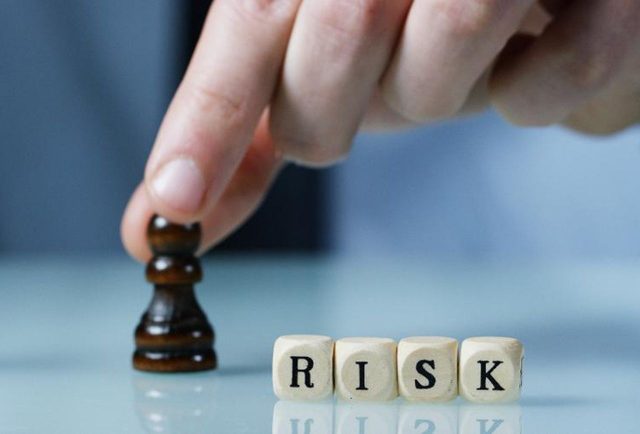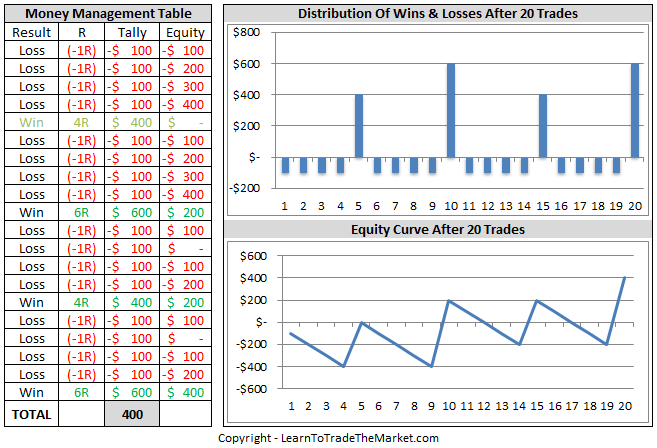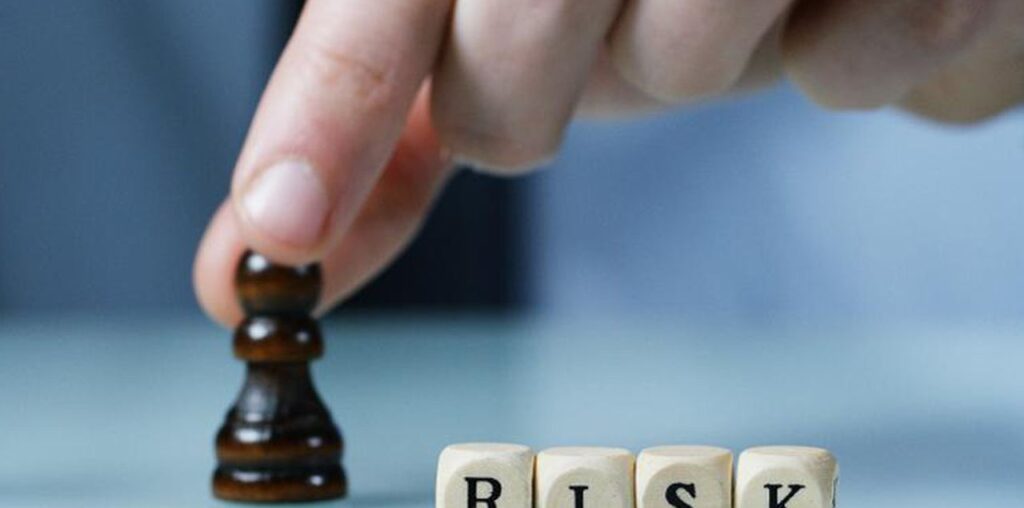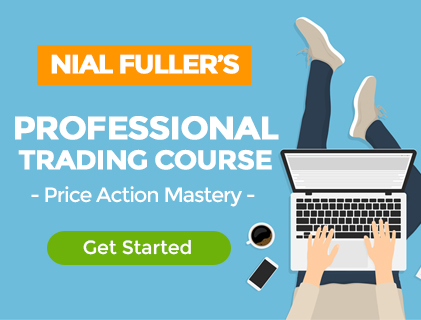
Is your trading account hurting? Do you feel overwhelmed, frustrated and ready to throw in the towel on the whole “trading thing”? Well, today’s lesson, if properly understood and implemented, can quite possibly provide you with the knowledge that you need to literally save your trading account and start building it back up.
You’ve probably heard that something like 90 to 95% of people who trade money in the markets or “speculate” in the markets, end up failing over the long-run. Whilst there can be a multitude of reasons for this mass failure, the primary one that underlies all the other ones is typically poor or no risk management skills. Often, traders don’t even understand risk management and just how important and powerful it is.
Hence, in today’s lesson, we are going to dive into the seemingly “boring” topic of risk management (but actually it’s super interesting if you like MAKING MONEY). Forget about everything else, all the hype, all the trading ‘systems’, because I am going to explain and show you the most important piece of the trading “puzzle” as you read on below…
Don’t Start a ‘War’ You Aren’t Prepared to Win.
There are essentially three main aspects to trading success: technical ability, which is chart-reading, price action trading, or whatever trading strategy you choose (I obviously use and teach price action strategies for a variety of reasons), money management which is “capital preservation” and encompasses things like how much $ will you risk per trade, position sizing, stop loss placement and profit targets. Then, there is the mental side, or trading psychology, and all three of these things, technical, money management and mental, are interconnected and intertwined in such a way that if one is missing, the other two essentially mean nothing.
Today, we are focusing on money management obviously, and honestly if you ask me, I would say that money management is the MOST important of the 3 pieces discussed above. Why? Simple: if you aren’t focusing on money management enough and taking care of it properly, your mindset is going to be totally wrong and whatever technical chart reading ability you have is essentially useless without the Money and Mind pieces in place.
So, before you start trading with your real, hard-earned money, you have to ask yourself one question: are you starting a trading ‘war’ that you really aren’t prepared to win? This is what most traders do, and most traders lose. If you don’t understand the concepts in this lesson and that I expand upon in my advanced trading course, you aren’t prepared to win.
Never Leave the Castle Unprotected!
What good what it be for an entire army to ride out into a war and leave the castle with all its riches (gold, silver, civilians) unprotected and unguarded? That’s why there is always a defense in place. Even in today’s military, there is always a “national guard” on reserve, waiting and watching in case any country tries to attack. The truth is that humans have ALWAYS defended that which is most important to them, so why not defend your money!?!?!
You protect and pro-long and GROW YOUR TRADING ACCOUNT by defending it FIRST and foremost. THEN, you go and execute potential winning trades. Remember, “rules of engagement 101 for trading”: NEVER leave your bank account unprotected when you go out to fight the “battle” of trading. Now, what exactly does that mean to you as a trader and more importantly, how do you do it??
It means, you do not start trading live, with real money, until you have a comprehensive trading plan in place. Your trading plan should detail things like what is your risk per trade? What amount of money are you comfortable with potentially losing on any given trade? What is your trading edge and what should you need to see on the charts before you pull the trigger on a trade? Of course, there is a lot more to a trading plan, but these are some of the most important pieces. For more, check out the trading plan template I provide in my courses.
I never go into the “battle of trading” unless I believe I have a strong chance of winning (high probability price action signal with confluence), but I also always assume I COULD LOSE (because any trade can lose) so I always make sure my defense is set in place as well!
Why “Being a Good Trader” is Not Enough…
Excessive use of leverage also known as taking “stupid risks” or stupidly big risks, are the main cause of trading account blowouts and failure. This is also why even the best traders can blow-up and lose all their money or all their clients’ money and you may have even heard of some hedge-funds blowing up in recent years, this is due to excess leverage as well as fraud in some cases.
In his popular blog “The Naked Dollar”, author Scott C. Johnston discusses how many high-profile hedge-fund managers have ruined hundred million dollar investment accounts simply because they did not protect the capital properly. You see, it really only takes one overly-confident or “cocky” trader to convince himself and others that he is “sure” of something and then put on an overly-leveraged position that leads to disaster.
The point is this…There are many “good traders” in the world and many of them even get employed by major banks and investment firms like Goldman Sachs and others. However, not all of them last long enough to generate significant returns because they simply lack the mental ability to manage risk, plan for losses and execute capital preservation correctly and consistently over long periods of time. A “good trader” is not just someone who can read a chart and predict its next move, but its someone who knows how to manage risk and control their risk capital and market exposure and who does so CONSISTENTLY ON EVERY TRADE.
If your capital preservation skills suck, you’re going to be a loser at trading, it’s just math, plain and simple. This is why some of the best traders (chart technicians) and market analysts end up as “nobodies”. If you want to be a “somebody” in the market, you MUST learn capital preservation and DO IT FOREVER over and over.
Why I Get Super Psyched About Risk Management!
Contrary to popular opinion amongst the trading masses, risk management is very, very interesting and exciting. Why? Simple. It’s because IT’S WHAT MAKES YOU MONEY IN THE MARKETS.
However, most traders just sort of gloss over risk management as “something I’ll do later” or some other ridiculous justification. But, really it should be the first and main thing they are focused on. A lot of times traders do this because they simply are ignorant to the POWER of proper money management, so let’s discuss that:
Why Risk Management is So Powerful and How To Use it:
What is the key to making consistent money in the markets over time so that you can actually make a living trading? It’s simple; stay in the market long enough to let your edge play out in your favor. However, most traders blow out their accounts long before this can happen, due to poor capital management skills. Hopefully, you will learn to remedy this situation for yourself.
Here is how you make money as a trader:
- Contain all your losses below a certain dollar level that you have pre-determined as your personal 1R risk amount that you are OK with losing on any given trade.
- Trade your edge properly and let it play out over time so that you have some bigger winners in between your smaller losers.
Honestly, that about sums it up. But most traders over-complicate the whole thing and shoot themselves in the foot over and over until they have no money left.
Now, in the image below, I want you to see what is going on and understand it and then IMPLEMENT IT IMMEDIATELY in your trading.
What the graphs below are showing is that:
- Winning percentage is not that important. In the example below, the win rate is about 20% and the trader still made money! How? Properly managing risk capital. Notice how all the losses are the same amount but some of the winners are 4R or 6R? This is what a winning trading performance looks like. It’s also fine to have some 2R winners mixed in as well.
- You need to have a mental obsession with capital preservation. You have your maximum 1R dollar risk amount and then you have to decide how much money you want to risk on any trade at that 1R max OR LESS, but you NEVER go over it. You will see in the image below the 1R max was $100 per trade.
- Yes, there were more losses than wins, by quite a bit, but because the capital management / preservation was SO consistent and disciplined, the winners more than took care of the losers!
Let this example serve as wake up call to those of you who don’t practice disciplined capital preservation. Study these examples below and go out and start practicing it in the real world.

How do you actually employ money management?
I have written about my ideas and theory on money management more extensively in several articles over the years. The topics I have covered include:
Risk Reward is the metric by which we define the risk and potential reward of a trade. If the risk reward doesn’t make sense on a trade, then we need to pass it up and wait for a better one. Read more about it in the following articles:
There are different philosophies on risk management out there and sadly, many of them are little more than rubbish and they end up hurting beginning traders rather than helping them. Read the following article to learn why one popular risk management system, “the 2% rule” is maybe not the ideal way to control your risk per trade:
Stop loss placement has a direct impact on risk management because where you place your stop determines how big of a position size you can trade and position size is how you control your risk. Read this article to learn more:
Position sizing is the actual process of entering the number of lots or contracts (the position size) you are trading on a particular trade. It’s the stop loss distance combined with the position size that determines the amount of money you are risking on a trade. Learn more here:
Placing profit targets as well as the entire process of profit-taking can easily be made overly-complex. Not to say it’s “easy”, but there are definitely certain things you need to know about it that will help make it easier. Learn more here:
If you don’t already know, you will soon find out that exiting a trade can really mess with your head. You need to know everything about trade exits you possible can, and specifically the psychology of it all, before you can hope to exit trades successfully. You can learn more about trade exits here:
Conclusion
Most traders end up giving too much of their focus and time to the wrong aspects of trading. Yes, trading strategies, trade entries, technical analysis are all important and you have to know what you’re doing and have a trading plan and understand what your edge is to make money. But, those things alone are simply not enough. You need the right “fuel” on the fire to make money in the markets. That “fuel” is risk management. You must understand risk management and how important it is and how to implement it in your trading. Hopefully this lesson has given you some insight into that.
If you want to better understand how price action trading, trading psychology and money management work together to form a complete trading approach, then you will need more training, study and experience. To get started, check out my advanced price action trading course and get off the “hamster wheel” that poor risk management skills bring about (repeating the same mistakes over and over) and learn how a professional thinks about and trades the market.
Please Leave A Comment Below With Your Thoughts On This Lesson…
If You Have Any Questions, Please Contact Me Here.




